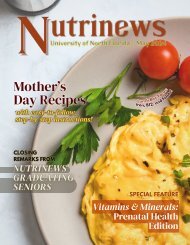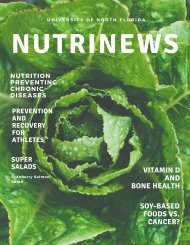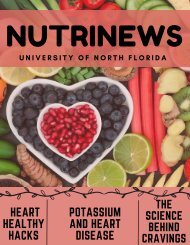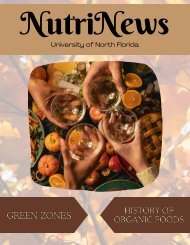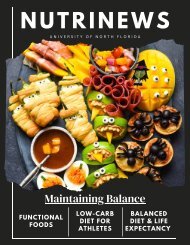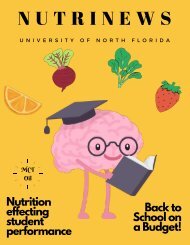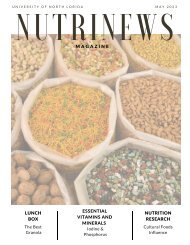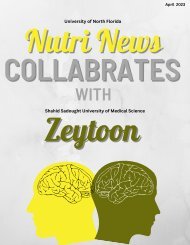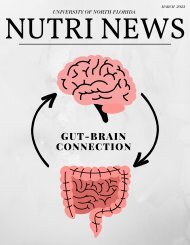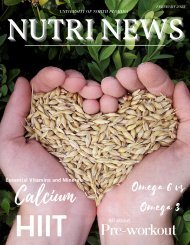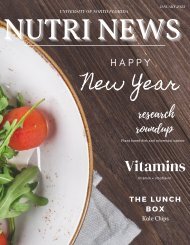September 2023 Issue
Hello readers! This month the theme for the September NutriNews magazine is the benefits of fiber within our diet. In this issue you can find of variety of information such as why we need fiber within our diets, how we can incorporate fiber in meals, how fiber impacts athletic performance, information on acacia fiber, and so much more. We hope you enjoy reading!
Hello readers! This month the theme for the September NutriNews magazine is the benefits of fiber within our diet. In this issue you can find of variety of information such as why we need fiber within our diets, how we can incorporate fiber in meals, how fiber impacts athletic performance, information on acacia fiber, and so much more. We hope you enjoy reading!
Create successful ePaper yourself
Turn your PDF publications into a flip-book with our unique Google optimized e-Paper software.
U N I V E R S I T Y O F N O R T H F L O R I D A<br />
NUTRINEWS<br />
BENEFITS<br />
OF<br />
FIBER<br />
Acacia<br />
Fiber
TABLE OF CONTENTS<br />
"YOUR DIET IS A BANK ACCOUNT. GOOD FOOD<br />
CHOICES ARE GOOD INVESTMENTS."<br />
Bethenny Frankel<br />
04.<br />
MESSAGE FROM THE CHAIR<br />
Chair of the Nutrition and Dietetics at the UNF<br />
NUTRITION SCIENCE<br />
07. Acacia Fiber<br />
08.<br />
09.<br />
LUNCH BOX<br />
Fruit Parfait<br />
MONTHLY HACKS<br />
Easy Ways to Implement Fiber in the Diet<br />
NUTRITION RESEARCH<br />
13. What is Fiber?<br />
16.<br />
SPORTS NUTRITION<br />
Fiber Impacting Athlete Performance<br />
NUTRINEWS STAFF<br />
22. Meet the Team
Message from<br />
the Chair<br />
MY NAME IS ANDREA ARIKAWA, AND I AM A PROFESSOR AND CHAIR<br />
OF THE DEPARTMENT OF NUTRITION AND DIETETICS AT UNF. JUST A<br />
LITTLE BIT ABOUT MYSELF, I AM ORIGINALLY FROM SÃO PAULO,<br />
BRAZIL, BUT I HAVE BEEN LIVING IN THE U.S FOR OVER 23 YEARS. I<br />
HAVE A PH.D IN NUTRITION FROM THE UNIVERSITY OF MINNESOTA<br />
AND PRIOR TO JOINING UNF IN 2014, I CONDUCTED RESEARCH<br />
STUDIES AS A RESEARCH ASSISTANT PROFESSOR. I CURRENTLY<br />
TEACH RESEARCH-FOCUSED CLASSES IN OUR DOCTORATE<br />
PROGRAM AND MY RESEARCH INTERESTS INVOLVE INFLAMMATION,<br />
DIET, AND THE MICROBIOME.<br />
I WOULD LIKE TO TAKE A MOMENT TO EXTEND A WARM WELCOME TO<br />
ALL AS WE STEP INTO THE FALL SEMESTER, AND TO SHARE WITH<br />
YOU ONE OF MY GOALS FOR THIS ACADEMIC YEAR. ONE OF MY<br />
PRIORITIES OVER THE NEXT FEW MONTHS IS TO STRENGTHEN THE<br />
CONNECTION BETWEEN THE DEPARTMENT OF NUTRITION AND<br />
DIETETICS AND OUR ALUMNI. WE WILL START BY KEEPING YOU<br />
INFORMED ABOUT THE DEPARTMENT’S ACHIEVEMENTS, PROVIDING<br />
MORE OPPORTUNITIES FOR NETWORKING, AND FACILITATING THE<br />
EXCHANGE OF RESOURCES AND SCHOLARLY OUTPUTS THAT COULD<br />
PIQUE YOUR INTEREST.<br />
4
THIS YEAR, WE HAVE SEEN AN EXCITING INCREASE IN OUR<br />
STUDENT ENROLLMENT. WE WELCOMED 60 STUDENTS INTO<br />
OUR UNDERGRADUATE PROGRAMS, 45 STUDENTS INTO OUR<br />
MASTER’S PROGRAMS, AND 12 STUDENTS INTO OUR<br />
DOCTORATE IN CLINICAL NUTRITION PROGRAMS. OUR<br />
NEWEST PROGRAM IS THE INTEGRATED FUTURE GRADUATE<br />
PROGRAM, WHICH STARTED IN THE FALL 2022 AND IS<br />
FLOURISHING UNDER THE DIRECTION OF DR. JAMISHA<br />
LEFTWICH. LASTLY, I AM PLEASED TO INTRODUCE TO YOU<br />
NUTRINEWS, A MONTHLY PUBLICATION ENTIRELY PRODUCED<br />
BY OUR NUTRITION STUDENTS UNDER THE EXPERT GUIDANCE<br />
OF DR. ALI JAHAN-MIHAN. THIS SERVES AS AN ILLUSTRATION<br />
OF THE TYPES OF SCHOLARLY PRODUCTS WE INTEND TO<br />
SHARE WITH YOU ON A REGULAR BASIS. I HOPE YOU ENJOY<br />
IT!<br />
IN THE FORTHCOMING MONTH, I HOPE TO SHARE WITH YOU<br />
MORE EXCITING NEWS ABOUT OUR DEPARTMENT. I AM ALSO<br />
KEEN ON HEARING ABOUT YOUR INSIGHTS ON POTENTIAL<br />
AVENUES THROUGH WHICH WE CAN FORTIFY OUR<br />
CONNECTION WITH OUR ALUMNI. WE WILL BE REACHING OUT<br />
SOON.<br />
THANK YOU FOR BEING PART OF OUR COMMUNITY!<br />
5
HAPPY<br />
LABOR DAY<br />
LETS<br />
CELEBRATE<br />
OUR<br />
___________________<br />
HARD WORK<br />
___________________
FOOD SCIENCE<br />
Acacia Fiber<br />
and gastrointestinal health<br />
By: Brianna Ransome<br />
What is acacia fiber, and<br />
how does it affect gastrointestinal health?<br />
Cacia gum (AG), a remarkable soluble secretion found on the trunks<br />
and branches of Acacia Senegal and Acacia Seyal trees, has<br />
emerged as a versatile hydrocolloid with a wide array of applications<br />
in both food and non-food industries. Its unique properties, including<br />
low viscosity and high solubility in water, have made it a favored<br />
choice for emulsification, encapsulation, coating, and<br />
confectioneries, accounting for more than three-quarters of its<br />
industrial uses. However, beyond its functional applications, AG is<br />
recognized for its potential as a prebiotic, offering exciting<br />
possibilities for promoting gut health.<br />
What Makes AG a Promising Prebiotic?<br />
As the term suggests, prebiotics serve as food for our gut<br />
microbiota, the diverse community of microorganisms residing in our<br />
digestive system. AG's distinctive composition meets the stringent<br />
criteria to be regarded as a prebiotic. It resists digestion from the<br />
mouth to the duodenal phase, ensuring it reaches the colon intact,<br />
where colonic microbes can ferment it. This fermentation process<br />
stimulates the growth of beneficial probiotics, such as<br />
Bifidobacterium and Lactobacillus, associated with improved gut<br />
health and overall well-being.<br />
Moreover, AG has been linked to producing short-chain fatty acids<br />
(SCFAs) during fermentation. SCFAs, such as acetate, propionate,<br />
and butyrate, are crucial in maintaining a healthy gut environment.<br />
They lower luminal pH, creating an unfavorable environment for<br />
harmful pathogens, and provide energy for the cells lining the<br />
intestinal wall, thereby enhancing intestinal motility.<br />
The soluble secretion from Acacia trees, known as Cacia gum or<br />
AG, is not just a mere food additive but a potential prebiotic that<br />
can contribute to a healthier gut microbiota. Its ability to<br />
selectively nourish beneficial probiotics and promote the<br />
production of SCFAs makes it a fascinating ingredient for<br />
exploration. AG may find itself in the spotlight as a critical player<br />
in improving gut health and overall well-being as research<br />
advances.<br />
References<br />
Rawi, M. H., Abdullah, A., Ismail, A., & Sarbini, S. R. (2021). Manipulation of Gut Microbiota Using Acacia Gum Polysaccharide. ACS omega, 6(28),<br />
17782–17797. https://doi.org/10.1021/acsomega.1c00302<br />
7
The Lunch Box<br />
COMFORTING FALL<br />
FRUIT PARFAIT<br />
By: Jace Brown<br />
A hallmark of the fall is<br />
undoubtedly its home-cooked<br />
foods. While comforting, many<br />
of these staples don’t contain<br />
much nutrition. If you’re looking<br />
for a taste of fall that’s equally<br />
nutritious, a fall fruit parfait may<br />
be your answer.<br />
This recipe gets its fiber mainly<br />
from sliced apples and bran<br />
flakes.According to the Mayo<br />
Clinic an apple contains about<br />
4.5 grams of fiber.<br />
Furthermore, bran flakes have<br />
5.5 grams of fiber per three<br />
fourths of a cup. Other<br />
increases to the fiber content<br />
are almonds which include 3.5<br />
grams of fiber in one ounce<br />
and dried cranberries with 2.3<br />
grams per 0.33 cup.<br />
Ingredients:<br />
• Pumpkin spice yogurt<br />
• Sliced apples<br />
• Dried Cranberries<br />
• Bran flakes<br />
• Almonds (Optional)<br />
• Cinnamon (Optional)<br />
8
Monthly Hacks<br />
HOW TO ADD<br />
MORE FIBER TO<br />
YOUR MEALS<br />
By: Sophia Harris<br />
Fiber is an important carbohydrate that is<br />
needed to maintain homeostatic balance<br />
within the body. It regulates how the body<br />
uses sugar, prolongs satiety, and controls<br />
blood sugar. Fiber also reduces the risk of<br />
obtaining certain conditions, such as heart<br />
disease, diabetes, diverticular disease,<br />
constipation, and some cancers. 1
10<br />
There are many ways to increase the<br />
amount of fiber you consume. One way<br />
is to incorporate fruits and vegetables<br />
into every meal, as many fruits and<br />
vegetables contain the fiber that is<br />
needed to gain those health benefits. It’s<br />
best to eat three servings of vegetables<br />
and two servings of fruit at every meal in<br />
order to consume the right amount of<br />
fiber needed for each day. 2 Some fruits<br />
that are high in fiber include raspberries,<br />
apples, oranges, tangerines, pears,<br />
blueberries, and strawberries. 3<br />
Cauliflower, carrots, sweet potatoes,<br />
squash, artichoke hearts, broccoli, Hass<br />
avocados, and Brussels sprouts are some<br />
vegetables that have a massive amount<br />
of fiber compared to other vegetables. 3<br />
You can also bump up your fiber intake<br />
by including nuts, seeds, and fruits in<br />
your snacks, as all are great sources of<br />
fiber. You can incorporate these into<br />
your diet by adding them to yogurt,<br />
oatmeal, salads, and stir-fries. 2<br />
If you are a person who likes to eat<br />
cereal in the morning, you can either<br />
choose a high fiber cereal or add a few<br />
tablespoons of wheat bran to a cereal<br />
that you already enjoy. Another easy way<br />
to integrate more fiber into your diet is<br />
to add or replace processed grains with<br />
whole grains. Focus on foods like brown<br />
rice, wild rice, barley, whole wheat<br />
pasta, whole wheat bread, and bulgur<br />
wheat. You can also add fiber to baked<br />
goods by using whole grain flour,<br />
crushed bran cereal, unprocessed wheat<br />
bran, or uncooked oats when baking<br />
cookies, muffins, and cakes.<br />
Adding more legumes to your diet can<br />
also increase your fiber intake. Beans<br />
can be incorporated into several meals,<br />
such as soups, salads, and even nachos.<br />
4 Alternatively, you can use legumes to<br />
replace meat in recipes like chili. 3 Some<br />
examples of high-fiber legumes include<br />
lentils, split peas, black beans, pinto<br />
beans, kidney beans, chickpeas, green<br />
peas, and edamame. 5 Incorporating oat<br />
bran or wheat germ into salads, soups,<br />
yogurt, and cereal can also be a good<br />
way to add more fiber to meals that may<br />
be lacking in this macronutrient.
In addition, whole fruits, especially the<br />
ones mentioned above, can help increase<br />
the amount of fiber in your diet. Whole<br />
fruits are better than fruit juices because<br />
they have more fiber than juice. Therefore,<br />
adding whole fruits to your baked goods<br />
can also increase the fiber content of baked<br />
sweets. 3 Salads are another excellent way<br />
to pack in more high-fiber foods. Dark leafy<br />
greens like kale, arugula, and spinach are<br />
great sources of fiber, and you can add<br />
other ingredients like legumes, whole<br />
grains, seeds, nuts, and fruits to further<br />
increase the amount of fiber in your salads.<br />
You can even add these ingredients to<br />
foods like yogurt and oatmeal if you need a<br />
boost of fiber. 6<br />
When it comes to snacks, know that<br />
they do not have to just consist of plain<br />
fruit and nuts; you can be a bit creative.<br />
For example, try air-popped popcorn,<br />
celery and peanut butter, carrots and<br />
hummus, orange and string cheese, kale<br />
chips and guacamole, sunflower seeds<br />
and ¼ cup of cottage cheese, blueberries<br />
and a dollop of Greek yogurt, or a fruit<br />
salad with a drizzle of fruit juice or<br />
yogurt. 5,6 Remember that there are an<br />
infinite number of ways to consume<br />
fiber. I hope that this article helps you<br />
find the ways that work best for you!<br />
References<br />
1. Harvard School of Public Health. Fiber. The Nutrition Source. Published June 6, 2018. Accessed July 31, <strong>2023</strong>.<br />
https://www.hsph.harvard.edu/nutritionsource/carbohydrates/fiber/.<br />
2. Mayo Clinic. Dietary fiber: Essential for a healthy diet. Mayo Clinic website. Published November 4, 2022. Accessed July 31, <strong>2023</strong>.<br />
https://www.mayoclinic.org/healthy-lifestyle/nutrition-and-healthy-eating/in-depth/fiber/art-20043983.<br />
3. Harvard Medical School. How to get more fiber in your diet. Harvard Health Publishing. Published May 20, 2021. Accessed July 31, <strong>2023</strong>.<br />
https://www.health.harvard.edu/staying-healthy/how-to-get-more-fiber-in-your-diet.<br />
4. UCSF Health. Increasing fiber intake. UCSF Health. Published March 14, 2019.Accessed July 31, <strong>2023</strong>.<br />
https://www.ucsfhealth.org/education/increasing-fiber-intake.<br />
5. Cleveland Clinic Health Essentials. 31 High-fiber foods you should be eating. Cleveland Clinic. Published March 10, <strong>2023</strong>. Accessed July 31,<br />
<strong>2023</strong>. https://health.clevelandclinic.org/high-fiber-foods/.<br />
6. Lehman S. 14 Simple ways to increase your fiber intake. Verywell Fit. Updated <strong>September</strong> 27, 2022. Accessed July 31, <strong>2023</strong>.<br />
https://www.verywellfit.com/why-your-body-needs-fiber-2505934.<br />
11
FALL FRUITS AND<br />
VEGETABLES<br />
VEGETABLES:<br />
BEETS<br />
BELL PEPPERS<br />
BROCCOLI<br />
BRUSSEL SPORUTS<br />
CABBAGE<br />
CARROTS<br />
CAULIFLOWER<br />
CELERY<br />
COLLARD GREENS<br />
GARLIC<br />
GINGER<br />
GREEN BEANS<br />
HERBS<br />
KALE<br />
LETTUCE<br />
MUSHROOMS<br />
ONIONS<br />
PARSNIPS<br />
PEAS<br />
POTATOES<br />
RADISHES<br />
RUTABAGAS<br />
SPINACH<br />
SWEET POTATOES<br />
SWISS CHARD<br />
TURNIPS<br />
FRUITS:<br />
APPLES<br />
BANANAS<br />
CRANBERRIES<br />
GRAPES<br />
KIWI<br />
LEMONS<br />
LIMES<br />
MANGOS<br />
PEARS<br />
PINEAPPLES<br />
PUMPKINS<br />
RASPBERRIES<br />
WINTER SQUASH<br />
12<br />
HTTPS://SNAPED.FNS.USDA.GOV/RESOURCES/NUTRITION-EDUCATION-<br />
MATERIALS/SEASONAL-PRODUCE-GUIDE/FALL
NUTRITION RESEARCH<br />
Fiber<br />
What is fiber and why do we need it in our diet?<br />
BY: TAVIANNA BROOKS<br />
Fiber, also called dietary fiber or roughage, is<br />
a member of the carbohydrate family that<br />
plays a significant role in our health.1-4 Unlike<br />
other carbohydrates that break down into<br />
glucose during digestion, fiber does not<br />
undergo digestion.1-4 Rather, fiber passes<br />
through the intestines undigested,<br />
regulating bowel movements and<br />
maintaining bowel health.1-4 You have<br />
probably heard of fiber’s ability to prevent<br />
constipation.1-4 Fiber softens and increases<br />
the weight and size of stool, allowing it to<br />
pass through easily.1-4 In addition to bowel<br />
health, fiber’s functions include controlling<br />
blood sugar, lowering cholesterol levels, and<br />
increasing satiety.1-4<br />
The main fiber categories are soluble<br />
and insoluble, but they can be further<br />
divided based on their fermentability,<br />
viscosity, and if they are dietary and/or<br />
functional (some fibers can occur<br />
naturally in plants and be synthetically<br />
made as well).1-4 A fiber’s ability to<br />
dissolve in water is the main difference<br />
between soluble and insoluble fibers.1-4<br />
As soluble fiber passes through the<br />
intestines, it creates a gel-like material,<br />
which feeds good gut bacteria.2<br />
Insoluble fiber, on the other hand, builds<br />
up material to create stool and promote<br />
bowel movements.1,3<br />
13
NUTRITION RESEARCH<br />
14<br />
Naturally-occurring dietary fibers include<br />
cellulose, hemicellulose, lignins, betaglucans,<br />
pectins, guar gum,<br />
oligosaccharides, and resistant starches.2<br />
Cellulose and hemicellulose are found in<br />
plant cell walls and in cereal grains.2 Lignins<br />
are found in whole wheat products, nuts,<br />
and vegetables.2 Cellulose, hemicellulose,<br />
and lignins are all insoluble.2 Beta-glucans,<br />
found in oats and barley, are a type of<br />
soluble fiber that is highly fermentable in<br />
the intestines and acts as a prebiotic.2<br />
Pectins are another highly-fermentable<br />
soluble fiber found in fruits that slow<br />
digestion.2 Guar gum is a soluble,<br />
fermentable fiber commonly used in foods<br />
as a thickener.2 Oligosaccharides and<br />
resistant starches, found in various<br />
vegetables and whole wheat foods, are<br />
soluble, fermentable fibers that act as<br />
prebiotics.2 Functional fibers like psyllium,<br />
polydextrose, and polyols are extracted<br />
from plants or synthetically made.2<br />
Oligosaccharides, pectins, and resistant<br />
starches are a few examples of fibers that<br />
could be classified as dietary or functional.2<br />
American children and adults require 25<br />
to 35 grams of fiber daily; however, most<br />
Americans consume only 15 grams a<br />
day.2 Including more fiber in the diet<br />
may be beneficial because fiber<br />
consumption decreases the risk of<br />
chronic diseases like cancer and<br />
coronary heart disease.5 In a randomized<br />
controlled trial of French adults, the<br />
highest fiber intake recorded was<br />
associated with “lower risk of overweight<br />
and elevated waist-to-hip ratio, [and<br />
high] blood pressure.”6 In this study,<br />
soluble fiber was mentioned as being<br />
less effective;6 however, soluble fiber has<br />
been shown to reduce plasma<br />
cholesterol concentrations.7,8 Fiber is<br />
also associated with the maintenance of<br />
healthy body weight, as fiber-rich foods<br />
tend to have fewer calories and increase<br />
feelings of satiation.1,9<br />
REFERENCES<br />
1. MAYO CLINIC. DIETARY FIBER: ESSENTIAL FOR A HEALTHY DIET. MAYO CLINIC. PUBLISHED 2021.<br />
ACCESSED JULY 31, <strong>2023</strong>. HTTPS://WWW.MAYOCLINIC.ORG/HEALTHY-LIFESTYLE/NUTRITION-AND-<br />
HEALTHY-EATING/IN-DEPTH/FIBER/ART-20043983.<br />
2. HARVARD SCHOOL OF PUBLIC HEALTH. FIBER. THE NUTRITION SOURCE. PUBLISHED JUNE 6, 2018.<br />
ACCESSED JULY 31, <strong>2023</strong>.<br />
HTTPS://WWW.HSPH.HARVARD.EDU/NUTRITIONSOURCE/CARBOHYDRATES/FIBER/.<br />
3. CLEVELAND CLINIC. WHAT’S THE DIFFERENCE BETWEEN SOLUBLE AND INSOLUBLE FIBER?<br />
HEALTH ESSENTIALS FROM CLEVELAND CLINIC. PUBLISHED FEBRUARY 1, 2021. ACCESSED JULY 31,<br />
<strong>2023</strong>. HTTPS://HEALTH.CLEVELANDCLINIC.ORG/WHATS-THE-DIFFERENCE-BETWEEN-SOLUBLE-AND-<br />
INSOLUBLE-FIBER/.<br />
4. CDC. FIBER: THE CARB THAT HELPS YOU MANGE DIABETES. CENTERS FOR DISEASE CONTROL<br />
AND PREVENTION. PUBLISHED DECEMBER 28, 2021. ACCESSED JULY 31, <strong>2023</strong>.<br />
HTTPS://WWW.CDC.GOV/DIABETES/LIBRARY/FEATURES/ROLE-OF-FIBER.HTML.<br />
5. LATTIMER JM, HAUB MD. EFFECTS OF DIETARY FIBER AND ITS COMPONENTS ON METABOLIC<br />
HEALTH. NUTRIENTS. 2010;2(12):1266-1289. DOI:10.3390/NU2121266<br />
6. LAIRON D, ARNAULT N, BERTRAIS S, ET AL. DIETARY FIBER INTAKE AND RISK FACTORS FOR<br />
CARDIOVASCULAR DISEASE IN FRENCH ADULTS. AM J CLIN NUTR. 2005;82(6):1185-1194.<br />
DOI:10.1093/AJCN/82.6.1185<br />
7. GRUNDY MM, EDWARDS CH, MACKIE AR, GIDLEY MJ, BUTTERWORTH PJ, ELLIS PR. RE-<br />
EVALUATION OF THE MECHANISMS OF DIETARY FIBRE AND IMPLICATIONS FOR MACRONUTRIENT<br />
BIOACCESSIBILITY, DIGESTION AND POSTPRANDIAL METABOLISM. BR J NUTR. 2016;116(5):816-833.<br />
DOI:10.1017/S0007114516002610<br />
8. RIDEOUT TC, HARDING SV, JONES PJ, FAN MZ. GUAR GUM AND SIMILAR SOLUBLE FIBERS IN THE<br />
REGULATION OF CHOLESTEROL METABOLISM: CURRENT UNDERSTANDINGS AND FUTURE<br />
RESEARCH PRIORITIES. VASC HEALTH RISK MANAG. 2008;4(5):1023-1033. DOI:10.2147/VHRM.S3512<br />
9. LIU S, WILLETT WC, MANSON JE, HU FB, ROSNER B, COLDITZ G. RELATION BETWEEN CHANGES IN<br />
INTAKES OF DIETARY FIBER AND GRAIN PRODUCTS AND CHANGES IN WEIGHT AND DEVELOPMENT<br />
OF OBESITY AMONG MIDDLE-AGED WOMEN. AM J CLIN NUTR. 2003;78(5):920-927.<br />
DOI:10.1093/AJCN/78.5.920
SPORTS NUTRITION<br />
DOES FIBER INCREASE<br />
ATHLETIC PERFORMANCE?<br />
By: Andrea Butler<br />
16<br />
This type of food can be smooth, rough, bitter, sweet, bland, and most<br />
importantly, makes everything flow properly! That’s right, it’s fiber.<br />
Dietary fiber is located in plants, fungi, bacteria and can be chemically<br />
digested.1 In addition, fiber has three significant properties of<br />
fermentability, viscosity, and solubility.1 According to the CDC, fiber is<br />
classified into two types, soluble and insoluble.2 Soluble fiber<br />
dissolves in water helping the digestion process occur at a faster rate.<br />
This type of fiber is found in oats, berries, and beans. Insoluble fiber<br />
adds bulk to stool which causes bowel movements to increase. Some<br />
foods associated with insoluble fiber are vegetables, seeds, and whole<br />
grains. Since the body does not fully breakdown or absorb fiber, there<br />
is a relationship between an individual’s glycemic response and dietary<br />
fiber.2 For instance, Mizelman et al stated that foods high in soluble<br />
fiber have a low glycemic index, meaning the food will slow an increase<br />
in blood sugar.3 This mechanism is seen to benefit endurance athletes<br />
with their performance compared to foods with a high glycemic index<br />
that has an opposing result. The effect of low and high glycemic index<br />
carbohydrate intake before exercise has mixed outcomes showing<br />
either no benefits or improvement on performance.3
Therefore, Mizelman et al conducted a randomized control trial (RCT) to<br />
determine if university soccer players can obtain health benefits from a lowglycemic<br />
index, fiber rich diet without consequences on performance. 3 Twentyseven<br />
male and female athletes received either a pulse-based diet or continued<br />
on their regular diet for four weeks, with a two-week washout period and<br />
switching diets for another four weeks. The pulse-based diet encompassed two<br />
servings per day of split peas, lentils, chickpeas, or beans in meals. Two hours<br />
before soccer games the athletes were given lentil-based nutrition bars or high<br />
glycemic index nutrition bars. Furthermore, Mizelman et al measured body<br />
composition, serum lipids, and plasma insulin from blood samples. Athletic<br />
performance was assessed during match play in the fourth week of each diet<br />
phase to determine their velocity, accelerations, and decelerations.<br />
The results showed that women had higher HDL on the pulse-based diet<br />
compared to a regular diet at four weeks, with no effect on insulin. In terms of<br />
body composition, sex differences with men having lower fat % and fat mass<br />
compared to women. In addition, there were no notable contrasts in athletic<br />
performance between diet phases. For example, maximal velocity was 25 (3)<br />
km/h during the pulse-diet and 27 (3) km/h during the control-diet. Time spent<br />
resting/walking was 91 (6)% during the pulse-diet compared to 92 (5)% for the<br />
control-diet. Time spent running was 7 (3)% during the pulse-diet and 6 (3)%<br />
during the control-diet. Pulse diet players covered a mean distance of 9180<br />
compared to control diet players having a mean distance of 8987. Overall,<br />
despite the high fiber content of the pulse-based diet, there were no negative<br />
effects or significant improvements on athletic performance. 3<br />
17
Similarly, Grubic et al established a randomized crossover study with twelve<br />
resistance trained males to determine if a whey protein-plant fiber food bar<br />
would maintain glucose homeostasis and improve performance. 4 The athletes<br />
consumed a carbohydrate matched dextrose or a food bar containing 20 g of<br />
whey 30-minutes before, mid-way, and after intense exercise. The participants<br />
performed eleven resistance exercises and strength tests to rate perceptions of<br />
muscle soreness and hypoglycemia before and after the exercise. The researchers<br />
also measured blood samples to assess catabolic and inflammatory markers.<br />
The results of the study showed that blood glucose was significantly higher 30-<br />
minutes post ingestion for the carbohydrate group while insulin was greater with<br />
the whey protein-plant fiber food bar. The analysis revealed no significant<br />
interactions in muscle soreness for the food bar group; however, the<br />
carbohydrate group saw slight increases in ratings. In addition, there were no<br />
significant interactions between the strength tests and the food bar group.<br />
Whereas the lifting volume during the strength test was significantly reduced for<br />
the carbohydrate group. In terms of hypoglycemia, there were no significant<br />
effects in hypoglycemic symptoms or stomach upset. Overall, the main findings<br />
of Gubric et al demonstrates that ingesting the whey protein-plant fiber food bar<br />
before, during, and after exercise could promote a low-moderate glycemic<br />
response that can help athletes maintain exercise capacity and hasten recovery. 4<br />
Although both studies showed no negative consequences to a high fiber meal<br />
before exercising, no two athletes will experience similar outcomes in<br />
performance. Many athletes who perform in intermediate-high intensity sports<br />
fear increasing dietary fiber before exercising due to gastrointestinal (GI)<br />
discomfort during games. 3 An estimated 20-60% of athletes suffer from the<br />
stress caused by excessive exercise and depending on the intensity, between 30-<br />
60% suffer from GI symptoms. 5 This may be due to eating foods high on the<br />
glycemic index too close before the hours of exercising slows digestion and<br />
causes distress as the body attempts to distribute energy during the workout, as<br />
well as continue digesting the fiber. 3 Moreover, current GI troubles such as a<br />
“leaky gut” will negatively impact fiber digestion combined with intense exercise<br />
may result in bloating and diarrhea. 1<br />
18
According to Kapoor et al, researchers theorized that changes in diet and intense<br />
exercise can alter the gut microbiomes of humans but very few studies assess the<br />
connection to highly fit athletes. 5 Since fiber has properties of solubility and<br />
fermentability, dietary fiber such as guar gum can be metabolized by colonic<br />
bacteria into short-chain fatty acids (SCFAs). SCFAs are essential for gut health<br />
because they are the main energy source for colonic cells. Therefore, Kapoor et al<br />
developed a randomized crossover study to determine the influence of prebiotic<br />
partially hydrolyzed guar gum (PHGG) dietary fiber on the gut microbiota of male<br />
athletes who follow an exercise-rich lifestyle. The participants followed a daily<br />
6g PHGG dietary supplement or placebo for four weeks then went on a threeweek<br />
washout period. After the three weeks, the participants followed another<br />
four weeks of crossover alternative administration. All participants completed a<br />
quality of life questionnaire and fecal defecation characteristics questionnaire.<br />
Some categories were frequency, diarrhea, and loose or hard defecation. The<br />
researchers examined fecal samples from extracted DNA and determined gut<br />
microbiome abundance by a terminal restriction fragment length polymorphism<br />
(T-RFLP) analysis. Their main findings showed that PHGG intake significantly<br />
increased in phylum Actinobacterium but decreased in Bacteroidetes<br />
compared to the placebo. In addition, a high frequency of reduction in diarrhea<br />
during the questionnaire was associated with an abundance of phylum<br />
Firmicutes/Bacteroidetes ratio and genera Bacteroidetes/Prevotella ratio for<br />
the PHGG intervention compared to the placebo. The data revealed that even at<br />
low dosages, PHGG intake modulates GI microbiomes and improves gut health.<br />
Lastly, to determine whether the PHGG fiber influenced quality of life, covariates<br />
where taken from the participants. These results showed a positive correlation<br />
between Firmicutes and Bacteroidetes with food and exercise covariates. Thus,<br />
intaking PHGG dietary fiber positively influences the abundance of the gut<br />
microbiome in healthy athletes, improving exercise related GI symptoms and<br />
overall recovery. 5<br />
References:<br />
1. Jaago M, Timmusk US, Timmusk T, Palm K. Drastic Effects on the Microbiome of a Young Rower Engaged in High-Endurance Exercise After a Month Usage of a Dietary Fiber Supplement.<br />
Frontiers in nutrition (Lausanne). 2021;8:654008-654008. doi:10.3389/fnut.2021.654008<br />
2. Fiber: The CARB that helps you manage diabetes. Centers for Disease Control and Prevention. June 20, 2022. Accessed July 24, <strong>2023</strong>. https://www.cdc.gov/diabetes/library/features/role-offiber.html#:~:text=Specifically%2C%20fiber%20can%20help%3A,sugar%20in%20your%20target%20range.<br />
3. Mizelman E, Chilibeck PD, Hanifi A, Kaviani M, Brenna E, Zello GA. A Low-Glycemic Index, High-Fiber, Pulse-Based Diet Improves Lipid Profile, but Does Not Affect Performance in Soccer<br />
Players. Nutrients. 2020;12(5):1324-. doi:10.3390/nu12051324<br />
4. Grubic TJ, Sowinski RJ, Nevares BE, et al. Comparison of ingesting a food bar containing whey protein and isomalto-oligosaccharides to carbohydrate on performance and recovery from an<br />
acute bout of resistance-exercise and sprint conditioning: an open label, randomized, counterbalanced, crossover pilot study. Journal of the International Society of Sports Nutrition.<br />
2019;16(1). doi:10.1186/s12970-019-0301-z<br />
5. Kapoor MP, Koido M, Kawaguchi M, et al. Lifestyle related changes with partially hydrolyzed guar gum dietary fiber in healthy athlete individuals – A randomized, double-blind, crossover,<br />
placebo-controlled gut microbiome clinical study. Journal of functional foods. 2020;72:104067-. doi:10.1016/j.jff.2020.104067<br />
19
HAPPY<br />
GRANDPARENT'S<br />
DAY!<br />
10 SEPTEMBER<br />
<strong>2023</strong>
Meet the team<br />
Editor in Chief<br />
Delaney<br />
Tindal<br />
Co-Editor in Chief<br />
Leigh Anne<br />
Vanzant<br />
Head Publisher<br />
Ashley<br />
Demmery<br />
Media Manager<br />
Maddie<br />
Levenson<br />
Faculty Advisor<br />
Dr. Alireza<br />
Jahan-Mihan<br />
Treasurer<br />
Grace<br />
Scoggins<br />
22
Meet the team<br />
Secretary Flyer Creator Publisher<br />
Izzy<br />
Kaitlin<br />
Bailey<br />
Vicario Fredrick Taylor<br />
Publisher<br />
Carole<br />
Stringfield<br />
Editor<br />
Giovana<br />
Faria<br />
Editor<br />
Sophia<br />
Sardella<br />
23
Meet the team<br />
Editor Writer Writer<br />
Ali<br />
Tavianna Brianna<br />
Walker<br />
Brooks Ransome<br />
Writer<br />
Jace<br />
Brown<br />
Writer<br />
Andrea<br />
Butler<br />
Writer<br />
Sophia<br />
Harris<br />
24
Meet the team<br />
Writer<br />
Madi<br />
Cashman<br />
25




